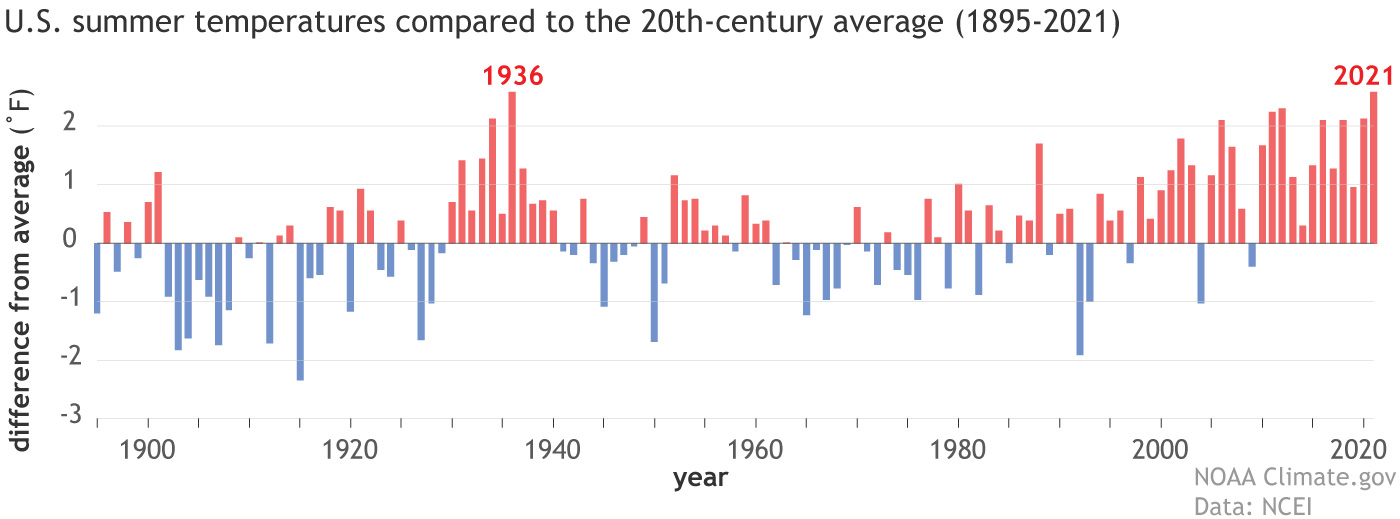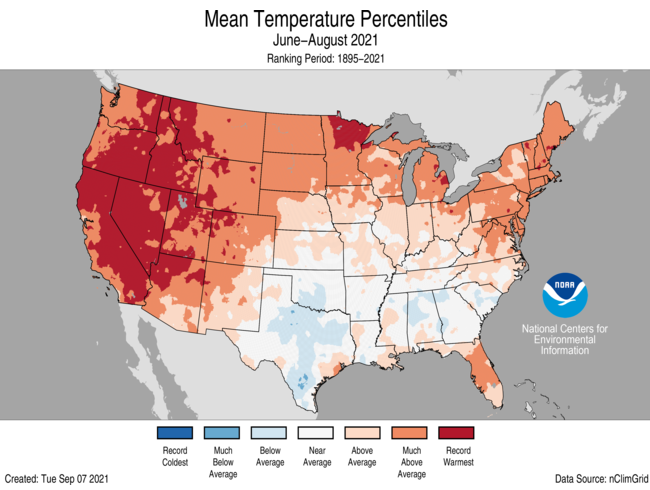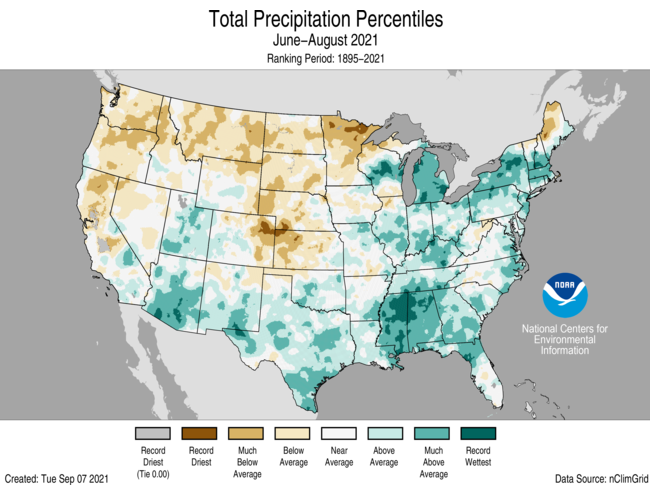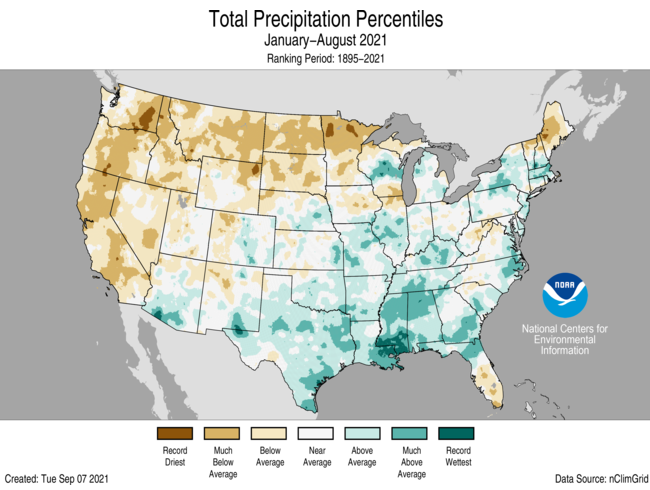Summer 2021 Neck and Neck with Dust Bowl Summer for Hottest on Record
Special Stories
15 Sep 2021 1:30 AM
[Information from NOAA, NOAA Climate, and NOAA NCEI] Hurricane Ida, numerous wildfires and devastating floods, capped off a summer of record heat and rainfall for many states throughout the country.
2021 summer temperature (June–August) tied 1936 for the warmest summer on record, meaning this summer’s heat was equal to the extreme conditions the country experienced during the height of the Dust Bowl. Summers in the U.S. are growing warmer by 1.23 degrees F per century.
 Meteorological summer | June through August
The average temperature during meteorological summer for the contiguous U.S. was 74.0 degrees F, 2.6 degrees above average. This technically exceeds the record heat of the 1936 Dust Bowl Summer, but the difference is extremely small (less than 0.01 of a degree F).*
Meteorological summer | June through August
The average temperature during meteorological summer for the contiguous U.S. was 74.0 degrees F, 2.6 degrees above average. This technically exceeds the record heat of the 1936 Dust Bowl Summer, but the difference is extremely small (less than 0.01 of a degree F).*
 Summer temperatures were above average to record warmest from the West Coast to the Great Lakes and into the Northeast as well as across portions of the Mid-Atlantic and Gulf Coast. A record 18.4% of the contiguous U.S. experienced record-warm temperatures. California, Idaho, Nevada, Oregon and Utah each reported their warmest summer on record, as 16 other states had a top-five warmest summer on record. No state ranked below average for the summer season, although temperatures were below average regionally across portions of the southern Plains and Southeast. Warm overnight temperatures heavily influenced the warm summer temperatures, especially across portions of the Southeast, where daytime temperatures were below average for the season.
Summer temperatures were above average to record warmest from the West Coast to the Great Lakes and into the Northeast as well as across portions of the Mid-Atlantic and Gulf Coast. A record 18.4% of the contiguous U.S. experienced record-warm temperatures. California, Idaho, Nevada, Oregon and Utah each reported their warmest summer on record, as 16 other states had a top-five warmest summer on record. No state ranked below average for the summer season, although temperatures were below average regionally across portions of the southern Plains and Southeast. Warm overnight temperatures heavily influenced the warm summer temperatures, especially across portions of the Southeast, where daytime temperatures were below average for the season.
 The average summer precipitation total was 9.48 inches — 1.16 inches above average — making it the eighth-wettest summer in the historical record. Precipitation was above average across portions of the Great Basin and Southwest, from the southern Plains to the Great Lakes and across much of the eastern U.S. Mississippi had its wettest summer on record while Alabama, Massachusetts, Michigan and New York had a summer that ranked among their five wettest. Meanwhile, Minnesota had its seventh-driest summer on record as precipitation was below average from the Northwest to the western Great Lakes and into the central Plains.
Year to date | YTD, January through August
The average U.S. temperature for the first eight months of 2021 was 55.6 degrees F — 1.8 degrees above the 20th-century average — making it the 13th-warmest such YTD on record. It was above average from the West Coast to the Great Lakes and into the Northeast as well as across parts of the Mid-Atlantic and Southeast. California and Maine each reported their third-warmest YTD, while 16 other states had a top-10 warmest YTD. Temperatures were below average across much of the southern Plains and lower Mississippi Valley.
The average summer precipitation total was 9.48 inches — 1.16 inches above average — making it the eighth-wettest summer in the historical record. Precipitation was above average across portions of the Great Basin and Southwest, from the southern Plains to the Great Lakes and across much of the eastern U.S. Mississippi had its wettest summer on record while Alabama, Massachusetts, Michigan and New York had a summer that ranked among their five wettest. Meanwhile, Minnesota had its seventh-driest summer on record as precipitation was below average from the Northwest to the western Great Lakes and into the central Plains.
Year to date | YTD, January through August
The average U.S. temperature for the first eight months of 2021 was 55.6 degrees F — 1.8 degrees above the 20th-century average — making it the 13th-warmest such YTD on record. It was above average from the West Coast to the Great Lakes and into the Northeast as well as across parts of the Mid-Atlantic and Southeast. California and Maine each reported their third-warmest YTD, while 16 other states had a top-10 warmest YTD. Temperatures were below average across much of the southern Plains and lower Mississippi Valley.

 January-August precipitation was above average from the Deep South to the Midwest, across the Southeast and portions of the Northeast. Mississippi had its third-wettest YTD on record, while Montana had its fifth driest. California, Minnesota and North Dakota all had a top-10 driest YTD on record. Precipitation was below average from the West Coast to the western Great Lakes and across portions of northern New England.
Edited for WeatherNation by Mace Michaels
January-August precipitation was above average from the Deep South to the Midwest, across the Southeast and portions of the Northeast. Mississippi had its third-wettest YTD on record, while Montana had its fifth driest. California, Minnesota and North Dakota all had a top-10 driest YTD on record. Precipitation was below average from the West Coast to the western Great Lakes and across portions of northern New England.
Edited for WeatherNation by Mace Michaels
 Meteorological summer | June through August
The average temperature during meteorological summer for the contiguous U.S. was 74.0 degrees F, 2.6 degrees above average. This technically exceeds the record heat of the 1936 Dust Bowl Summer, but the difference is extremely small (less than 0.01 of a degree F).*
Meteorological summer | June through August
The average temperature during meteorological summer for the contiguous U.S. was 74.0 degrees F, 2.6 degrees above average. This technically exceeds the record heat of the 1936 Dust Bowl Summer, but the difference is extremely small (less than 0.01 of a degree F).*
 Summer temperatures were above average to record warmest from the West Coast to the Great Lakes and into the Northeast as well as across portions of the Mid-Atlantic and Gulf Coast. A record 18.4% of the contiguous U.S. experienced record-warm temperatures. California, Idaho, Nevada, Oregon and Utah each reported their warmest summer on record, as 16 other states had a top-five warmest summer on record. No state ranked below average for the summer season, although temperatures were below average regionally across portions of the southern Plains and Southeast. Warm overnight temperatures heavily influenced the warm summer temperatures, especially across portions of the Southeast, where daytime temperatures were below average for the season.
Summer temperatures were above average to record warmest from the West Coast to the Great Lakes and into the Northeast as well as across portions of the Mid-Atlantic and Gulf Coast. A record 18.4% of the contiguous U.S. experienced record-warm temperatures. California, Idaho, Nevada, Oregon and Utah each reported their warmest summer on record, as 16 other states had a top-five warmest summer on record. No state ranked below average for the summer season, although temperatures were below average regionally across portions of the southern Plains and Southeast. Warm overnight temperatures heavily influenced the warm summer temperatures, especially across portions of the Southeast, where daytime temperatures were below average for the season.
 The average summer precipitation total was 9.48 inches — 1.16 inches above average — making it the eighth-wettest summer in the historical record. Precipitation was above average across portions of the Great Basin and Southwest, from the southern Plains to the Great Lakes and across much of the eastern U.S. Mississippi had its wettest summer on record while Alabama, Massachusetts, Michigan and New York had a summer that ranked among their five wettest. Meanwhile, Minnesota had its seventh-driest summer on record as precipitation was below average from the Northwest to the western Great Lakes and into the central Plains.
Year to date | YTD, January through August
The average U.S. temperature for the first eight months of 2021 was 55.6 degrees F — 1.8 degrees above the 20th-century average — making it the 13th-warmest such YTD on record. It was above average from the West Coast to the Great Lakes and into the Northeast as well as across parts of the Mid-Atlantic and Southeast. California and Maine each reported their third-warmest YTD, while 16 other states had a top-10 warmest YTD. Temperatures were below average across much of the southern Plains and lower Mississippi Valley.
The average summer precipitation total was 9.48 inches — 1.16 inches above average — making it the eighth-wettest summer in the historical record. Precipitation was above average across portions of the Great Basin and Southwest, from the southern Plains to the Great Lakes and across much of the eastern U.S. Mississippi had its wettest summer on record while Alabama, Massachusetts, Michigan and New York had a summer that ranked among their five wettest. Meanwhile, Minnesota had its seventh-driest summer on record as precipitation was below average from the Northwest to the western Great Lakes and into the central Plains.
Year to date | YTD, January through August
The average U.S. temperature for the first eight months of 2021 was 55.6 degrees F — 1.8 degrees above the 20th-century average — making it the 13th-warmest such YTD on record. It was above average from the West Coast to the Great Lakes and into the Northeast as well as across parts of the Mid-Atlantic and Southeast. California and Maine each reported their third-warmest YTD, while 16 other states had a top-10 warmest YTD. Temperatures were below average across much of the southern Plains and lower Mississippi Valley.

 January-August precipitation was above average from the Deep South to the Midwest, across the Southeast and portions of the Northeast. Mississippi had its third-wettest YTD on record, while Montana had its fifth driest. California, Minnesota and North Dakota all had a top-10 driest YTD on record. Precipitation was below average from the West Coast to the western Great Lakes and across portions of northern New England.
Edited for WeatherNation by Mace Michaels
January-August precipitation was above average from the Deep South to the Midwest, across the Southeast and portions of the Northeast. Mississippi had its third-wettest YTD on record, while Montana had its fifth driest. California, Minnesota and North Dakota all had a top-10 driest YTD on record. Precipitation was below average from the West Coast to the western Great Lakes and across portions of northern New England.
Edited for WeatherNation by Mace MichaelsAll Weather News
More